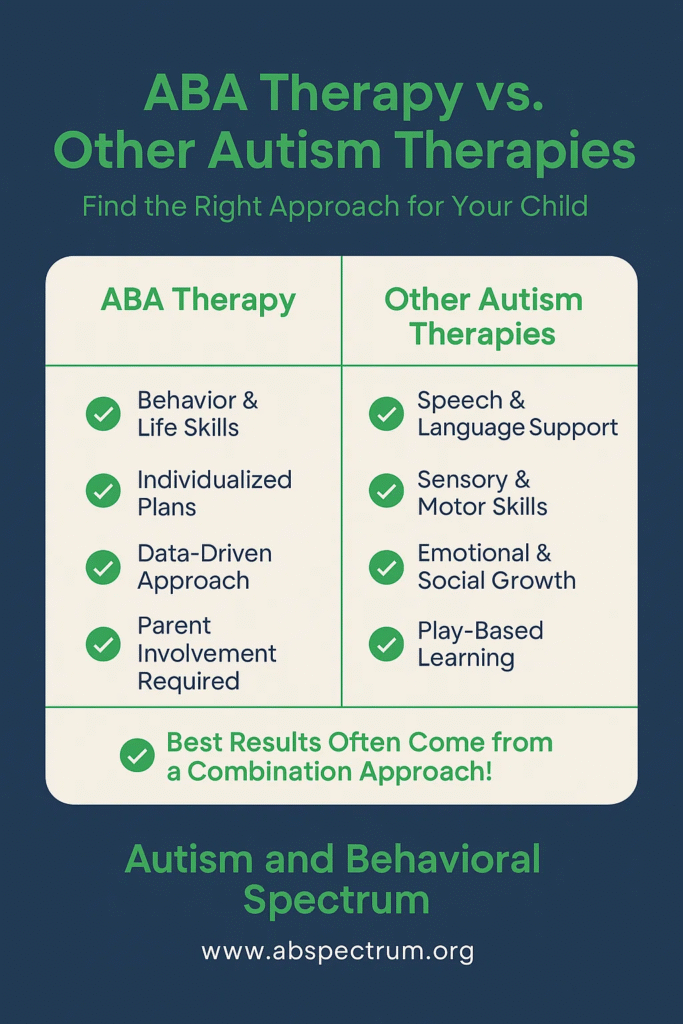ABA Therapy for Autism: Effective Applied Behavior Analysis Techniques
Applied Behavior Analysis (ABA), also known as Behavioral Analysis Therapy or Applied Behavioral Therapy, is a highly effective, evidence-based autism treatment. ABA Therapy for Autism focuses on increasing useful behaviors while reducing those that interfere with learning and daily living. For many parents seeking a structured, research-backed autism therapy, ABA offers real hope, measurable progress, and long-term improvement.
Autism spectrum disorder (ASD) affects how a child communicates, behaves, and interacts socially. Early Autism Therapy interventions like ABA are crucial in helping children build foundational life skills. ABA’s use of Positive Reinforcement encourages desirable behaviors and minimizes problematic ones, leading to meaningful growth in everyday functioning.
What Is ABA Therapy for Autism and How Does It Work?
ABA is a structured method that uses Behavioral Analysis Techniques to teach socially significant behaviors such as communication, social interaction, and self-care. It is an Evidence-Based Autism Therapy grounded in observation, data collection, and customized interventions. Therapists focus on understanding behavior patterns, identifying the causes of challenges, and reinforcing positive behaviors through consistent rewards.
A core principle of ABA is Positive Reinforcement, where a child is rewarded for displaying desirable behaviors, greatly increasing the chance those behaviors will be repeated.
Read More: How Much Does ABA Therapy Cost
Key Components of ABA Therapy for Autism
1. Functional Behavior Assessment (FBA)
Every ABA therapy program begins with a Functional Behavior Assessment. This evaluation identifies the “why” behind behaviors, whether the behavior is triggered by sensory input, a desire to escape, gain attention, or obtain a tangible item.
The results lead to a tailored Behavior Intervention Plan (BIP), guiding all future Autism Behavioral Therapy interventions.
2. Behavioral Modification Therapy Techniques
Therapists then implement Behavioral Modification Therapy strategies. These involve replacing harmful or disruptive behaviors with socially appropriate alternatives. For example, a child prone to tantrums when denied a toy might be taught to request it using words or picture communication.
3. Positive Reinforcement in ABA
A key strategy in Behavior Therapy for Autism is Positive Reinforcement. When a child demonstrates a desired behavior like greeting a peer or following directions, they receive a meaningful reward such as a toy, praise, or extra playtime. This approach builds motivation and encourages repetition of good behavior.
4. Skill Development
ABA Therapy builds essential life skills through a step-by-step approach, including:
- Communication
- Social Interaction
- Self-Care
- Motor Skills
- Academic Abilities
Using proven ABA Therapy Techniques, therapists break down each complex task into smaller, teachable units, helping children achieve mastery at their own pace.
5. Ongoing Evaluation and Adjustment
ABA programs are dynamic. Therapists collect data regularly and make data-driven adjustments to ensure optimal progress. This continuous evaluation makes ABA one of the most effective and reliable ASD Behavioral Treatments.
Read More: How Long Will ABA Therapy Last?
The Reggio ABA Approach

At AB Spectrum, we take ABA one step further through the Reggio ABA approach. Inspired by the Reggio Emilia philosophy of early childhood education, Reggio ABA integrates creativity, exploration, and child-led learning into the structured framework of Applied Behavior Analysis. We believe children thrive when they are not only taught but also inspired.
Reggio ABA creates a warm, nurturing environment where therapists build on each child’s interests to teach essential life skills. Through collaborative projects, naturalistic teaching, and interactive environments, children are encouraged to express themselves, solve problems, and actively participate in their learning journey.
This blend of scientific structure and creative freedom helps children develop confidence, emotional regulation, and meaningful communication skills, while still gaining all the proven benefits of ABA therapy. Reggio ABA supports the whole child—cognitively, socially, emotionally, and behaviorally.
Benefits of ABA Therapy for Autism
ABA Therapy provides a wide range of benefits for children and families:
- Individualized Programs: Each child receives a custom plan tailored to their strengths, challenges, and developmental level.
- Proven Effectiveness: Numerous studies support ABA as one of the most effective Evidence-Based Autism Therapies.
- Skill Generalization: Children not only learn new skills but also apply them across different settings (home, school, and community).
- Reduction of Problematic Behaviors: ABA helps reduce aggression, self-injury, tantrums, and other challenging behaviors.
- Family Involvement: Parents are trained in ABA strategies to ensure consistency beyond therapy sessions.
- Improved Social Skills: Children enhance their ability to engage with peers and adults, forming meaningful connections.
- Enhanced Quality of Life: With stronger communication and daily living skills, children gain greater independence and confidence.
Read More: Benefits of Applied Behavior Analysis (ABA) Therapy for Children
ABA Therapy vs. Other Autism Therapy Methods

While other forms of Autism Therapy such as speech therapy and occupational therapy offer benefits, ABA stands out due to its scientific foundation and measurable outcomes. Its structured approach to Autism Behavior Support and Autism Behavior Modification addresses real-life challenges, making it a comprehensive solution for families.
Other therapies can complement ABA but often lack the same depth of data tracking, behavior analysis, and structured skill acquisition.
Why Choose AB Spectrum for Autism Treatment
AB Spectrum offers expert-designed ABA Therapy programs tailored to help children on the autism spectrum reach their full potential. Our approach combines cutting-edge Behavioral Analysis Techniques with compassionate care. We partner closely with families to ensure long-lasting change and growth. Whether you’re looking for early intervention or support for older children, AB Spectrum provides customized solutions rooted in science, empathy, and experience.
Is ABA Therapy Right for Your Child with Autism?
If your child is struggling with communication, daily tasks, or social interaction, ABA Therapy for Autism may be a life-changing option. With a personalized treatment plan and expert support from AB Spectrum, many families see measurable improvements in as little as 3 to 6 months.
Frequently Asked Questions (FAQs)
1. What is ABA Therapy for Autism?
ABA Therapy is an evidence-based treatment that improves socially significant behaviors in children with autism through behavior analysis and reinforcement strategies.
2. How does ABA differ from other Autism Therapy methods?
ABA is data-driven and focused on behavior modification, while other therapies may target sensory or language skills without a structured behavioral framework.
3. Is ABA suitable for all children with Autism?
Yes. ABA programs are personalized, making them suitable for children across the autism spectrum.
4. What is Positive Reinforcement in ABA?
It’s the process of rewarding desired behavior with something meaningful to increase the likelihood of repetition.
5. Can ABA Therapy help reduce problem behaviors?
Absolutely. ABA targets and replaces challenging behaviors like aggression, self-injury, or tantrums with appropriate alternatives.
6. What is Functional Behavior Assessment (FBA)?
FBA is the process of identifying the function behind behaviors to develop an effective Behavior Intervention Plan.
7. How long does it take to see results from ABA Therapy?
While each child is different, many families notice improvement within 3 to 6 months of consistent therapy.
8. Why choose AB Spectrum for Autism Treatment?
AB Spectrum provides expert-led, science-based ABA programs with a compassionate, family-centered approach.

